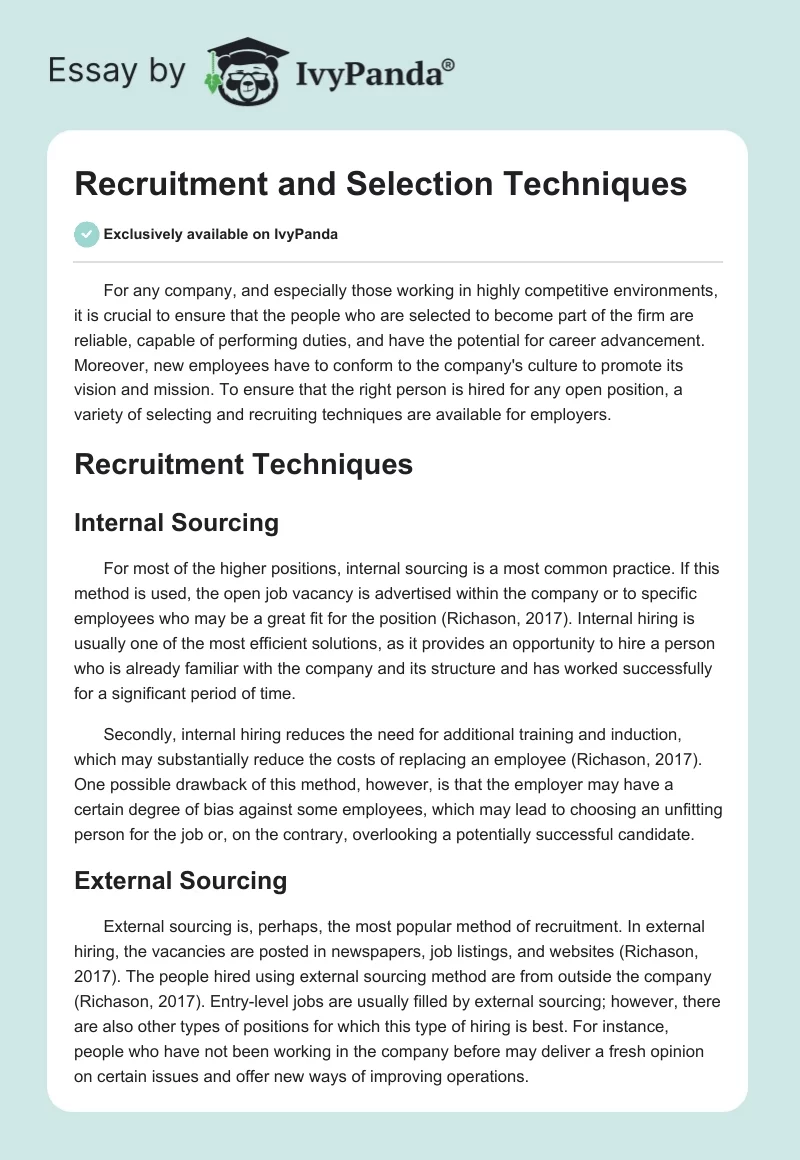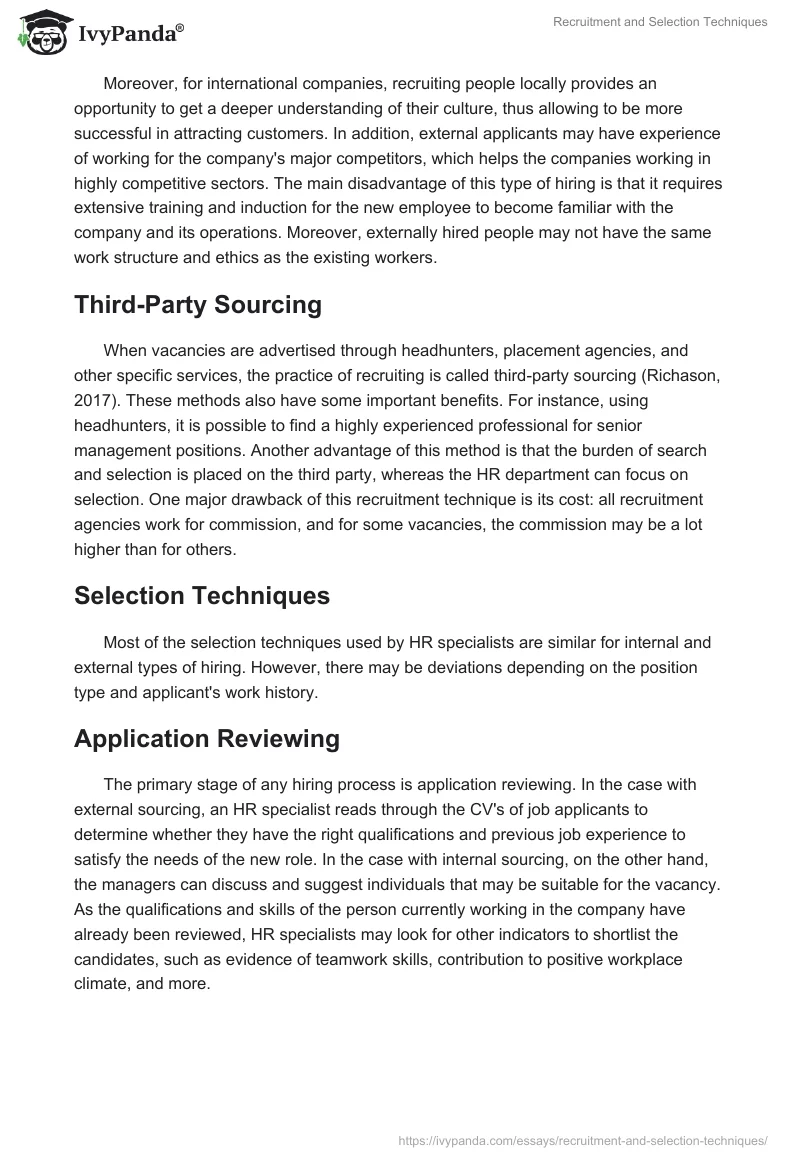For any company, and especially those working in highly competitive environments, it is crucial to ensure that the people who are selected to become part of the firm are reliable, capable of performing duties, and have the potential for career advancement. Moreover, new employees have to conform to the company’s culture to promote its vision and mission. To ensure that the right person is hired for any open position, a variety of selecting and recruiting techniques are available for employers.
Recruitment Techniques
Internal Sourcing
For most of the higher positions, internal sourcing is a most common practice. If this method is used, the open job vacancy is advertised within the company or to specific employees who may be a great fit for the position (Richason, 2017). Internal hiring is usually one of the most efficient solutions, as it provides an opportunity to hire a person who is already familiar with the company and its structure and has worked successfully for a significant period of time.
Secondly, internal hiring reduces the need for additional training and induction, which may substantially reduce the costs of replacing an employee (Richason, 2017). One possible drawback of this method, however, is that the employer may have a certain degree of bias against some employees, which may lead to choosing an unfitting person for the job or, on the contrary, overlooking a potentially successful candidate.
External Sourcing
External sourcing is, perhaps, the most popular method of recruitment. In external hiring, the vacancies are posted in newspapers, job listings, and websites (Richason, 2017). The people hired using external sourcing method are from outside the company (Richason, 2017). Entry-level jobs are usually filled by external sourcing; however, there are also other types of positions for which this type of hiring is best. For instance, people who have not been working in the company before may deliver a fresh opinion on certain issues and offer new ways of improving operations.
Moreover, for international companies, recruiting people locally provides an opportunity to get a deeper understanding of their culture, thus allowing to be more successful in attracting customers. In addition, external applicants may have experience of working for the company’s major competitors, which helps the companies working in highly competitive sectors. The main disadvantage of this type of hiring is that it requires extensive training and induction for the new employee to become familiar with the company and its operations. Moreover, externally hired people may not have the same work structure and ethics as the existing workers.
Third-Party Sourcing
When vacancies are advertised through headhunters, placement agencies, and other specific services, the practice of recruiting is called third-party sourcing (Richason, 2017). These methods also have some important benefits. For instance, using headhunters, it is possible to find a highly experienced professional for senior management positions. Another advantage of this method is that the burden of search and selection is placed on the third party, whereas the HR department can focus on selection. One major drawback of this recruitment technique is its cost: all recruitment agencies work for commission, and for some vacancies, the commission may be a lot higher than for others.
Selection Techniques
Most of the selection techniques used by HR specialists are similar for internal and external types of hiring. However, there may be deviations depending on the position type and applicant’s work history.
Application Reviewing
The primary stage of any hiring process is application reviewing. In the case with external sourcing, an HR specialist reads through the CV’s of job applicants to determine whether they have the right qualifications and previous job experience to satisfy the needs of the new role. In the case with internal sourcing, on the other hand, the managers can discuss and suggest individuals that may be suitable for the vacancy. As the qualifications and skills of the person currently working in the company have already been reviewed, HR specialists may look for other indicators to shortlist the candidates, such as evidence of teamwork skills, contribution to positive workplace climate, and more.
Interviews
For many companies, it is recommended that at least one face-to-face interview is conducted before a hiring decision is made (Mayhew, 2017). For external applicants, the interviews usually determine his or her awareness of the company, as well as a discussion of past work experience, roles, and more. For internal candidates, on the other hand, the questions asked during an interview may be more specific and related to the applicant’s work in the company so far.
Testing
Testing is an optional part of the recruitment process, which is usually required for specific jobs that require a certain degree of knowledge in some subjects, such as languages, engineering, etc. Testing results may be used by the recruiter in support of the applicant’s CV and interview experience, to prove the person’s suitability for the job.
Candidate Selection
The final stage of any choice process is the selection of a single applicant who fits the criteria of the position best. During this stage, recruiters and managers compare the results obtained by previous selection techniques and determine the person who will be made a job offer.
Conclusion
Overall, the selection process is an important part of HR specialist’s work, as it ensures that any person that becomes part of the company is fully suited for her or his role and will fit well into the company’s culture. Different recruitment methods, on the other hand, allow adjusting the process by the specifics of the position to be fulfilled.
References
Mayhew, R. (2017), Methods of HR selection techniques. Web.
Richason, O. E. IV. (2017). Methods of recruitment & selection. Web.


